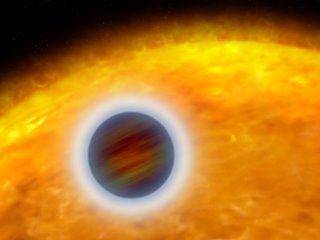Hubble Alien Worlds

_______________________________________________________
Artists's Concept STScI-PRC2007-07
The powerful vision of NASA's Hubble Space Telescope has allowed astronomers to study for the first time the structure of the atmosphere of a planet orbiting another star. Hubble discovered a dense upper layer of hot hydrogen gas where the super-hot planet's atmosphere is bleeding off into space.
Starlight is heating the planet's atmosphere, causing hot gas to escape into space. Astronomers used Hubble to analyze the starlight that filtered through the planet's atmosphere. Imprinted on the starlight is information about the atmosphere's structure and chemical makeup.
The planet, designated HD 209458b, is unlike any world in our solar system. It orbits so close to its star and gets so hot that its gas is streaming into space, making the planet appear to have a comet-like tail. This new research reveals the layer in the planet's upper atmosphere where the gas becomes so heated it escapes, like steam rising from a boiler.
The Hubble data show how intense ultraviolet radiation from the host star heats the gas in the upper atmosphere, inflating the atmosphere like a balloon. The gas is so hot that it moves very fast and escapes the planet's gravitational pull at a rate of 10,000 tons a second, more than three times the rate of water flowing over Niagara Falls. The planet, however, will not wither away any time soon. Astronomers estimate its lifetime is more than 5 billion years.
The scorched planet is a big puffy version of Jupiter. In fact, it is called a "hot Jupiter," a large gaseous planet orbiting very close to its parent star. Jupiter might even look like HD 209458b if it were close to the Sun.
The planet completes an orbit around its star every 3.5 days. It orbits 4.7 million miles from its host, 20 times closer than the Earth is to the Sun. By comparison, Mercury, the closest planet to our Sun, is 10 times farther away from the Sun than HD 209458b is from its star. Unlike HD 209458b, Mercury is a small ball of iron with a rocky crust.
Although HD 209458b does not have a twin in our solar system, it has plenty of relatives beyond our solar system. About 10 to 15 percent of the more than 200 known extrasolar planets are hot Jupiters. A recent Hubble survey netted 16 hot Jupiter candidates in the central region of our Milky Way Galaxy, suggesting that there may be billions of these gas-giant star huggers in our galaxy.
Source hubblesite newscenter releases 31/01/2007
_______________________________________________________
_______________________________________________________
Famous Quotes:
Nothing happens unless first we dream. Carl Sandburg
_______________________________________________________
_______________________________________________________
Labels: exoplanets, Gas Giants, hubble


<< Home